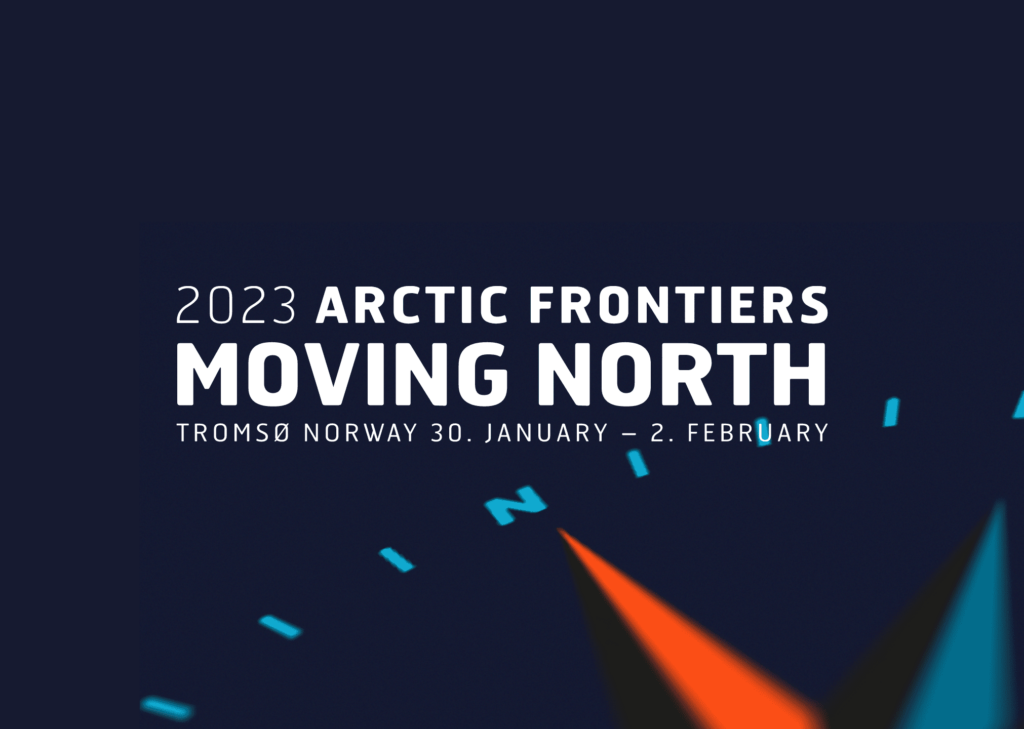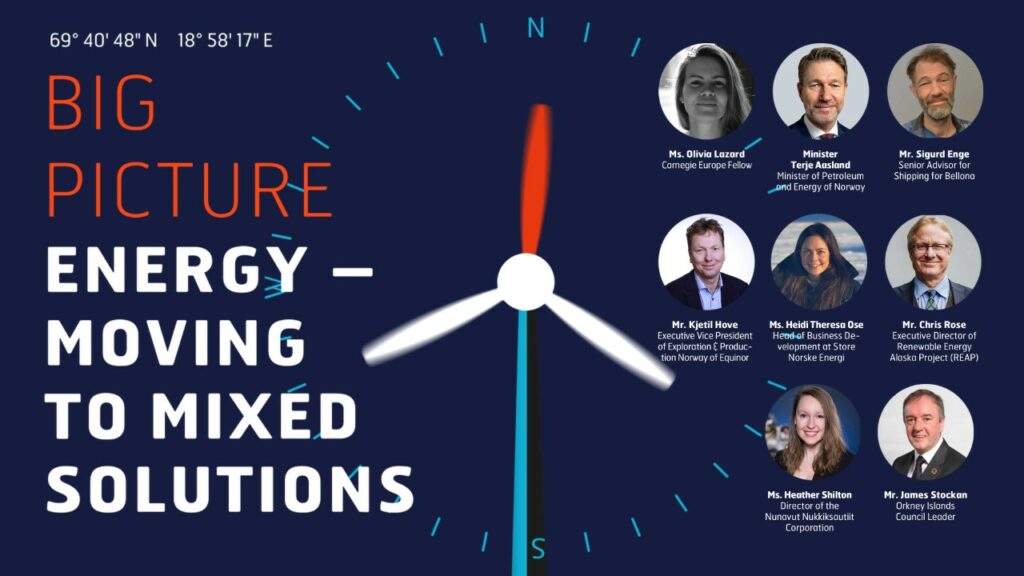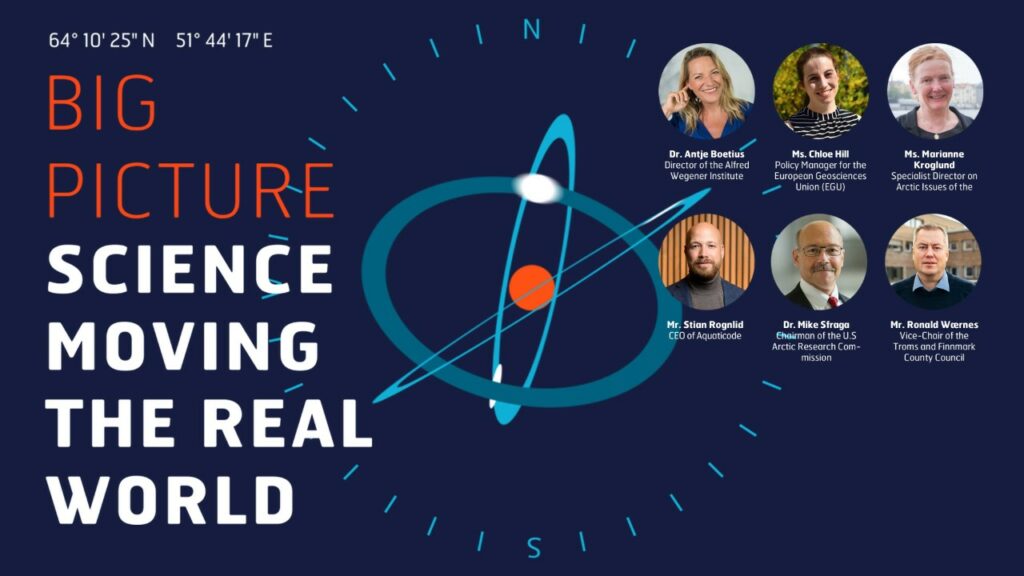
The theme of the 2023 Arctic Frontiers conference was Moving North. The conference had five Big Picture sessions, high-level discussions that combined expertise within science, policy and business to address the most pressing issues facing the Arctic Region. Read more about the sessions here:
All the sessions were recorded and can now be watched for free on our YouTube channel:
Moving North
Today, everything is on the move and so is the Arctic. The globe is more connected than ever and yet also more divided. Climate change impacts, geopolitical tensions, sea ice edge, technology hubs, businesses, flora and fauna – all are moving North, presenting unprecedented challenges and opportunities for sustainable development and for the peoples of the Arctic who are also on the move to and from the region.
February 2022 marked the end of Arctic exceptionalism, with conflict in Europe as a direct consequence of the actions of an Arctic nation. The knock-on effects of the war are vast, including humanitarian and refugee crises, food and energy insecurity, and the disruption of global supply chains. Pan-Arctic collaboration has been reduced to a minimum and we are still searching for new pathways for communication in this new geopolitical landscape.
There are multiple pressures on the Arctic, but we see the effects of climate change and the geopolitical situation as key drivers for development in the Arctic. What approaches can we take to tackle geopolitical instability and the climate emergency simultaneously? Is new technology part of the solution or a Pandora’s Box of new challenges? Exploring both long-term and short-term impacts and potential solutions will shape the main topics for the Arctic Frontiers 2023: Moving North conference.

North on the Move
This session focused on large global trends and the role of the Arctic in them. We will examine how the two global drivers – climate change and geopolitics – are impacting development in the Arctic. How are these drivers perceived in the Arctic, and what are the different perceptions of the future role of the region? What approaches are necessary to tackle geopolitical instability and the climate emergency simultaneously?
This session measured the pulse of the Arctic: what is the state of pan-Arctic collaboration, and is there a viable road map forward? How do we proceed in solving the most urgent issues facing the Arctic today and tomorrow while also addressing the challenges that the world at large presents? Do we see new opportunities or are we standing still at the crossroad? The session also focused on what the role of non-Arctic stakeholders is, when pan-Arctic collaboration as we knew it is still partially on hold? How can the rest of the world contribute to the region’s development, and is this contribution welcome within the Arctic?
Food on the Move
Climate change has a huge impact on the oceans, causing many marine species to migrate, adapt or even disappear. Human activity continues to influence the health of the ocean, and conversely humans are impacted by changes in ocean ecosystems. Local communities, indigenous peoples, businesses and legislation are in a constant process of adaptation to keep up with the changes and ensure that Arctic livelihoods, food security and environmental concerns are kept in balance.
War in Europe has the potential of keeping the global population hostage in terms of food security. The consequences are already visible in soaring prices, lack of fertilizer, and disruptions in value chains. What does this mean for the Arctic, a region rich in proteins and traditional food production? Different parts of the Arctic appear to be on different development trajectories regarding their potential for food production. Can this potential be scaled up to meet the growing demand? What role does the Arctic Ocean play in terms of food security both for the people of the Arctic and those outside the Arctic? Do we have the appropriate value chains and infrastructure in place? Will the local economies reap the benefit of new technologies, in the form of local value creation?


Moving To and From the North
One of the greatest societal challenges facing the pan-Arctic region is outmigration, especially of youth. We are witnessing a demographic pattern in the Arctic where some population centres are growing, because members of smaller communities are moving to regional hubs in search of services, education and employment opportunities.
Discussions on the national and international level can give the impression that protecting the Arctic and forbidding all development activities provides the best way of taking care of the region. But are there alternatives? For instance focusing on sustainable development resulting in net positive impact, which can help to reverse current demographic patterns. What are the factors that support people staying in the Arctic once they arrive? What is the role of new technologies in creating new opportunities in the Arctic? What are the different approaches to demographic challenges on the regional and national levels of governance? Should we fight against outmigration no matter how high the price?
Recent geopolitical developments have brought new perspectives related to the demographic development in the Arctic: the importance of the robust local communities from a national security point of view. Has there been a change in the national strategies? What are the short-term implications of this on the pan-Arctic scale?
This session focused on the push and pull factors for local populations and shed light on the driving factors of in-migration and examples for successful measures from inside and outside the Arctic for maintaining local populations.
Energy- Moving to Mixed Solutions
Energy security is a pressing global concern, and the acceleration of green energy development is at the forefront of everyone’s mind. The war in Ukraine has demonstrated that energy and security policies are intertwined. There is a call for stronger energy independency, multimodality and local energy production closer to the consumer and even by the consumer. What should be the strategy of the Arctic countries in terms of energy – regionally, nationally and internationally in this changed global environment? Are we moving from a “one provider” and “one source of energy” mentality to mixed solutions? Can off-grid solutions, local energy production and optimisation be “a new big thing” for the Arctic and from the Arctic?
NIMBY-ism (not in my backyard) is also gaining ground in the Arctic. Conflicts related to land use, traditional livelihoods and biodiversity are discussed widely across the region. How can we mitigate the impacts of energy-related developments and approach these challenges in a constructive way? Can multimodality and the bringing of energy production closer to users ensure that the energy transition also leads to regional value creation?


Science Moving the Real World
We produce new knowledge like never before. It is said that we have enough knowledge to solve the climate crisis, but are we capable of using newfound knowledge in political and business decision-making? Is science trusted by all? Are facts being exploited for the wrong purposes and how can science be communicated correctly? How can we make science more available and applicable in the governance of our societies? Are businesses better structured to accommodate the latest science into their everyday work? Can innovative businesses be the push that puts science on the agenda of the politicians on all levels? How can we make science “travel” into decision-making?
This session examined the mechanisms and structures that are in place, or should be in place, to ensure that decision making is knowledge-based, in general and in the Arctic in particular. Does knowledge-based mean pure academic science, traditional knowledge, or are there other sources that should be considered? Politicians, scientists, lobbyists, businessmen and representatives of indigenous communities from the Arctic and outside the region shared their perspectives on how to interpret the information and move them to the tables of the decision-makers.